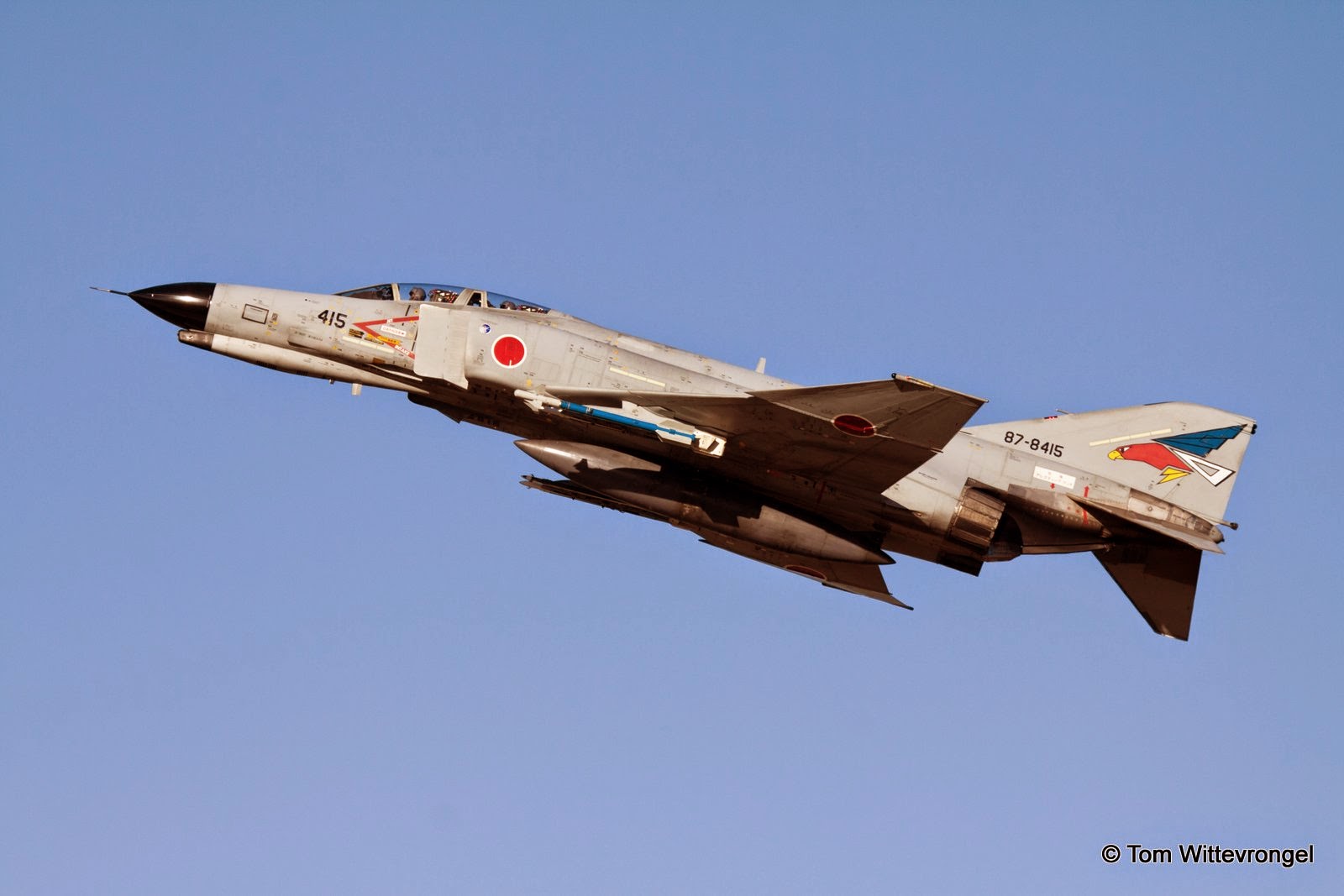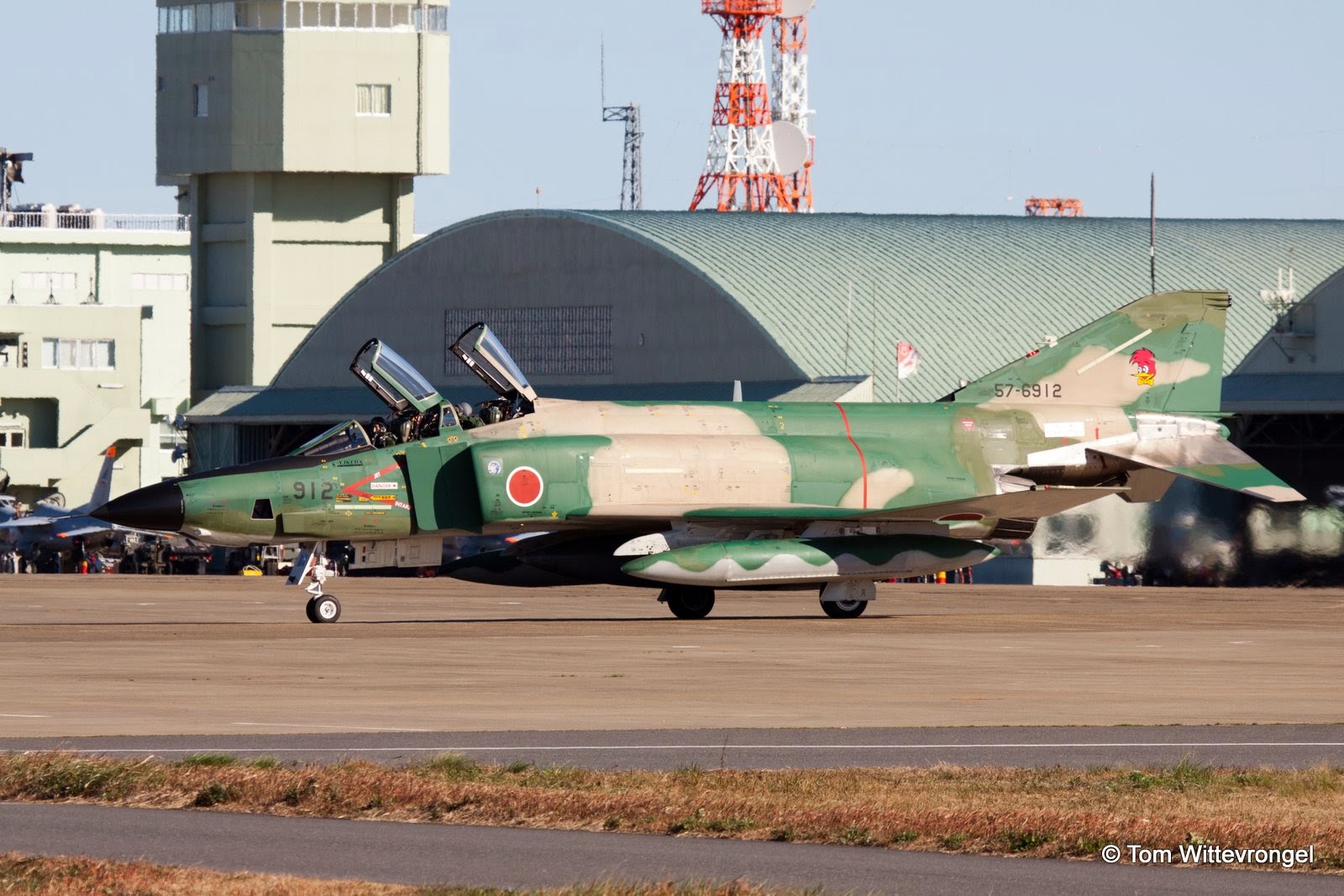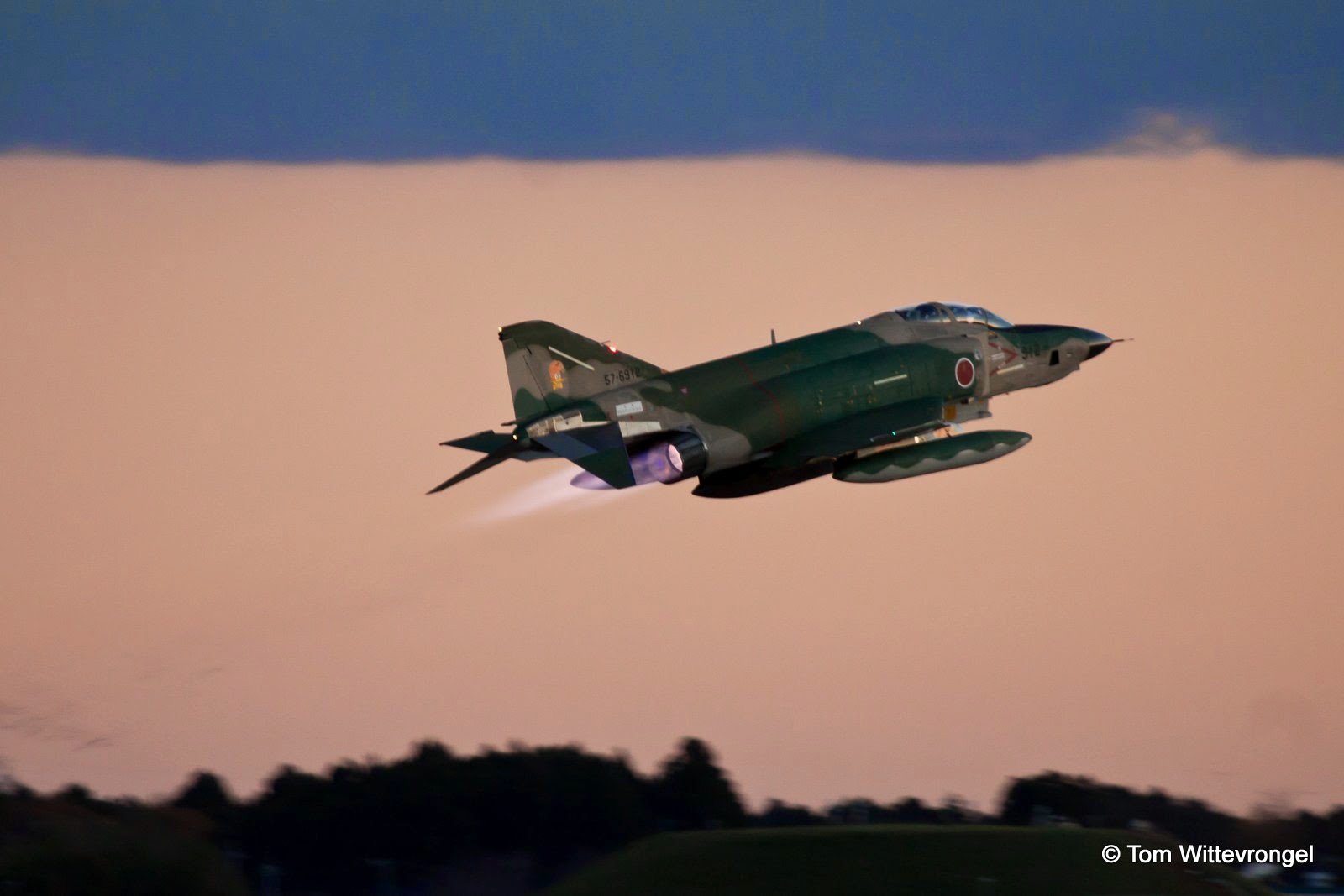Located just north of Tokyo, in the Ibaraki prefecture, the airfield at Hyakuri has a long and distinguished history, accurately reflecting the modern history of the Japanese armed forces in general. The history of the airfield dates back to 1937, when the Imperial Japanese Navy Air Service established a flying base near the city of Omitama. After Japans defeat in the Second World War, the Imperial Japanese Army and Navy were dissolved and the airfield closed and was returned to agricultural use.
After WWII, the United States occupied the Japanese Islands until 1954, and upon their withdrawal the Japan Self Defence Forces (JSDF) were established under tight conditions imposed by the new Japanese constitution which states, "The Japanese people forever renounce war as a sovereign right of the nation and the threat or use of force as means of settling international disputes" and declares, "land, sea, and air forces, as well as other war potential, will never be maintained."
In practice, the Japanese parliament authorised the establishment of the JSDF, but the status of the Forces tends to be the subject of much constitutional controversy, especially when the subject of any sort of capability upgrade or enhancement is discussed. The role of the JSDF is completely oriented towards the defence of Japan, with no offensive capability. The basic policy for national defence also requires that Japan avoids becoming a major military power that might pose a threat to the world.
With the establishment of the Japan Air Self Defence Force (JASDF), planning for the construction of its bases commenced and Hyakuri was selected for redevelopment as an airfield, despite the objections of local residents. The airfield opened for flying in 1966, but even today objections continue from local farmers, some of whom continue to farm small plots of land within the airfield perimeter.
There are three main flying units at Hyakuri, two of which fly variants of the F-4 Phantom, the third being equipped with the F-15. Most active of the F-4 units is 302 Hikotai, which is equipped with the F-4EJ Kai. Japan ordered a total of 140 F-4EJ Phantoms for delivery between 1971 and 1981. Of these, 138 were built in Japan by Mitsubishi.
The Mitsubishi F-4EJ Phantom was designed as a simplified version of the F-4E delivered to the USAF. In keeping with the JASDF role as a self defence force, the aircraft was designed without an in-flight refuelling capability, and all ground attack capabilities were also deleted.
A total of 96 aircraft were upgraded to F-4EJ Kai (modified) standard, and it is these aircraft which remain in service, in reduced numbers. There are two squadrons currently flying the F-4EJ - in addition to 302 Hikotai at Hyakuri, 301 Hikotai at Nyutabaru still operates this classic aircraft.
In a recent squadron swap, 302 Hikotai left their base at Naha, Okinawa in early 2009, with 204 Hikotai, an F-15J unit which were formerly resident at Hyakuri heading in the opposite direction. The F-4EJ unit has an air defence role, and now operates alongside 305 Hikotai, who fly the F-15J Eagle.
The aircraft the JASDF selected to replace the majority of its F-4 fleet was the F-15 Eagle. A total of 160 single seat F-15Js were delivered, long with 42 two-seat F-15DJs. Of this total, two F-15Js and 12 F-15DJs were built in the US, with the rest being built by Mitsubishi in Japan.
Today, around 150 Eagles of various marks remain in service, spread out throughout the Japanese islands as the JASDFs primary interceptor and air superiority fighter. It was recently decided to equip some of the F-15s with synthetic aperture radar pods, in order to perform a reconnaissance role, which is currently undertaken by the third front line squadron at Hyakuri, 501 Hikotai.
In addition to the F-4EJ order, the JASDF also ordered a smaller number unarmed of RF-4Es. In total, 14 aircraft were delivered, all of which were built in the US. In order to expand the fleet and replace aircraft lost in accidents, 17 surplus F-4EJs were converted for the reconnaissance role, becoming RF-4EJs. The survivors from both the original RF-4Es and the remaining RF-4EJs are now concentrated with 501 Hikotai.
The RF-4EJ lacks the distinctive camera nose of the RF-4E, retaining the gun nose of the F-4EJ. The reconnaissance sensors are carried externally in pods. This equipment can be changed depending on the mission required and includes the TACER electronic reconnaissance pod and the LOROP pod with cameras. Both the RF-4Es and RF-4EJs wear tactical camouflage colour schemes, in contrast to the all over grey of the air defence F-4EJs.
In addition to the frontline units at Hyakuri, there is also a Search and Rescue detachment, equipped with the British Aerospace U-125A along with the UH-60J. The U-125A is a variant of the BAe 125 Series 800 corporate jet, used for maritime SAR.
After WWII, the United States occupied the Japanese Islands until 1954, and upon their withdrawal the Japan Self Defence Forces (JSDF) were established under tight conditions imposed by the new Japanese constitution which states, "The Japanese people forever renounce war as a sovereign right of the nation and the threat or use of force as means of settling international disputes" and declares, "land, sea, and air forces, as well as other war potential, will never be maintained."
In practice, the Japanese parliament authorised the establishment of the JSDF, but the status of the Forces tends to be the subject of much constitutional controversy, especially when the subject of any sort of capability upgrade or enhancement is discussed. The role of the JSDF is completely oriented towards the defence of Japan, with no offensive capability. The basic policy for national defence also requires that Japan avoids becoming a major military power that might pose a threat to the world.
With the establishment of the Japan Air Self Defence Force (JASDF), planning for the construction of its bases commenced and Hyakuri was selected for redevelopment as an airfield, despite the objections of local residents. The airfield opened for flying in 1966, but even today objections continue from local farmers, some of whom continue to farm small plots of land within the airfield perimeter.
There are three main flying units at Hyakuri, two of which fly variants of the F-4 Phantom, the third being equipped with the F-15. Most active of the F-4 units is 302 Hikotai, which is equipped with the F-4EJ Kai. Japan ordered a total of 140 F-4EJ Phantoms for delivery between 1971 and 1981. Of these, 138 were built in Japan by Mitsubishi.
The Mitsubishi F-4EJ Phantom was designed as a simplified version of the F-4E delivered to the USAF. In keeping with the JASDF role as a self defence force, the aircraft was designed without an in-flight refuelling capability, and all ground attack capabilities were also deleted.
A total of 96 aircraft were upgraded to F-4EJ Kai (modified) standard, and it is these aircraft which remain in service, in reduced numbers. There are two squadrons currently flying the F-4EJ - in addition to 302 Hikotai at Hyakuri, 301 Hikotai at Nyutabaru still operates this classic aircraft.
In a recent squadron swap, 302 Hikotai left their base at Naha, Okinawa in early 2009, with 204 Hikotai, an F-15J unit which were formerly resident at Hyakuri heading in the opposite direction. The F-4EJ unit has an air defence role, and now operates alongside 305 Hikotai, who fly the F-15J Eagle.
The aircraft the JASDF selected to replace the majority of its F-4 fleet was the F-15 Eagle. A total of 160 single seat F-15Js were delivered, long with 42 two-seat F-15DJs. Of this total, two F-15Js and 12 F-15DJs were built in the US, with the rest being built by Mitsubishi in Japan.
Today, around 150 Eagles of various marks remain in service, spread out throughout the Japanese islands as the JASDFs primary interceptor and air superiority fighter. It was recently decided to equip some of the F-15s with synthetic aperture radar pods, in order to perform a reconnaissance role, which is currently undertaken by the third front line squadron at Hyakuri, 501 Hikotai.
In addition to the F-4EJ order, the JASDF also ordered a smaller number unarmed of RF-4Es. In total, 14 aircraft were delivered, all of which were built in the US. In order to expand the fleet and replace aircraft lost in accidents, 17 surplus F-4EJs were converted for the reconnaissance role, becoming RF-4EJs. The survivors from both the original RF-4Es and the remaining RF-4EJs are now concentrated with 501 Hikotai.
The RF-4EJ lacks the distinctive camera nose of the RF-4E, retaining the gun nose of the F-4EJ. The reconnaissance sensors are carried externally in pods. This equipment can be changed depending on the mission required and includes the TACER electronic reconnaissance pod and the LOROP pod with cameras. Both the RF-4Es and RF-4EJs wear tactical camouflage colour schemes, in contrast to the all over grey of the air defence F-4EJs.
In addition to the frontline units at Hyakuri, there is also a Search and Rescue detachment, equipped with the British Aerospace U-125A along with the UH-60J. The U-125A is a variant of the BAe 125 Series 800 corporate jet, used for maritime SAR.
 |
| U-125A Japanese Air Self Defence Force 72-3006 |
 |
| F-4EJ Japanese Air Self Defence Force 07-8434 |
 |
| F-4EJ Japanese Air Self Defence Force 87-8415 |
 |
| T-4 Japanese Air Self Defence Force 26-5679 |
 |
| F-15J Japanese Air Self Defence Force 22-8812 |
 |
| F-15J Japanese Air Self Defence Force 62-8875 |
 |
| F-15DJ Japanese Air Self Defence Force 32-8060 |
 |
| F-4EJ Japanese Air Self Defence Force 87-8415, 07-8434 |
 |
| F-4EJ Japanese Air Self Defence Force 87-8415, 07-8434 |
 |
| F-15J Japanese Air Self Defence Force 22-8805 |
 |
| F-15J Japanese Air Self Defence Force 82-8901 |
 |
| RF-4E Japanese Air Self Defence Force 57-6909 |
 |
| RF-4E Japanese Air Self Defence Force 57-6909 |
 |
| RF-4E Japanese Air Self Defence Force 57-6912 |
 |
| RF-4E Japanese Air Self Defence Force 57-6909 |
 |
| T-4 Japanese Air Self Defence Force 26-5687 |
 |
| RF-4E Japanese Air Self Defence Force 57-6907 |
 |
| RF-4E Japanese Air Self Defence Force 57-6907 |
 |
| RF-4E Japanese Air Self Defence Force 57-6907 |
 |
| F-15DJ Japanese Air Self Defence Force 32-8060 |
 |
| F-15J Japanese Air Self Defence Force 42-8828 |
 |
| F-15J Japanese Air Self Defence Force 42-8828 |
 |
| F-15J Japanese Air Self Defence Force 22-8805 |
 |
| F-15J Japanese Air Self Defence Force 72-8885, 22-8805 |
 |
| F-15J Japanese Air Self Defence Force 72-8885, 22-8805 |
 |
| F-15J Japanese Air Self Defence Force 22-8812 |
 |
| T-4 Japanese Air Self Defence Force 06-5640 |
 |
| RF-4E Japanese Air Self Defence Force 57-6909 |
 |
| RF-4E Japanese Air Self Defence Force 57-6909 |
 |
| RF-4E Japanese Air Self Defence Force 57-6912, 57-6907 |
 |
| RF-4E Japanese Air Self Defence Force 57-6907 |
 |
| RF-4E Japanese Air Self Defence Force 57-6912 |
 |
| F-4EJ Japanese Air Self Defence Force 87-8415 |
 |
| F-4EJ Japanese Air Self Defence Force 77-8399 |
 |
| F-4EJ Japanese Air Self Defence Force 77-8399 |
 |
| F-4EJ Japanese Air Self Defence Force 87-8413 |
 |
| F-15J Japanese Air Self Defence Force 62-8875 |
 |
| F-15J Japanese Air Self Defence Force 62-8875 |
 |
| F-15J Japanese Air Self Defence Force 82-8901 |
 |
| F-15J Japanese Air Self Defence Force 82-8901 |
 |
| F-4EJ Japanese Air Self Defence Force 07-8434 |
 |
| F-4EJ Japanese Air Self Defence Force 87-8413 |
 |
| RF-4E Japanese Air Self Defence Force 57-6909 |
 |
| RF-4E Japanese Air Self Defence Force 57-6912 |
 |
| RF-4EJ Japanese Air Self Defence Force 07-6433 |
 |
| F-4EJ Japanese Air Self Defence Force 07-8435 |
 |
| F-4EJ Japanese Air Self Defence Force 07-8435 |
 |
| F-4EJ Japanese Air Self Defence Force 87-8415 |
 |
| F-15J Japanese Air Self Defence Force 62-8875 |
 |
| F-15J Japanese Air Self Defence Force 42-8842 |
 |
| F-15J Japanese Air Self Defence Force 32-8826 |
 |
| F-15DJ Japanese Air Self Defence Force 32-8060 |
 |
| F-15J Japanese Air Self Defence Force 62-8875 |
 |
| F-15J Japanese Air Self Defence Force 42-8842 |
 |
| F-15J Japanese Air Self Defence Force 82-8901 |
 |
| RF-4E Japanese Air Self Defence Force 57-6912 |
 |
| F-15J Japanese Air Self Defence Force 72-8885 |
 |
| F-15DJ Japanese Air Self Defence Force 32-8060 |
 |
| U-125A Japanese Air Self Defence Force 72-3006 |
 |
| F-15J Japanese Air Self Defence Force 72-8885 |
 |
| F-15J Japanese Air Self Defence Force 22-8812 |
 |
| F-15J Japanese Air Self Defence Force 42-8828 |
 |
| RF-4E Japanese Air Self Defence Force 57-6912 |
 |
| RF-4E Japanese Air Self Defence Force 57-6912 |
 |
| RF-4E Japanese Air Self Defence Force 57-6912 |
 |
| RF-4E Japanese Air Self Defence Force 57-6907 |
 |
| RF-4EJ Japanese Air Self Defence Force 07-6433 |

No comments:
Post a Comment